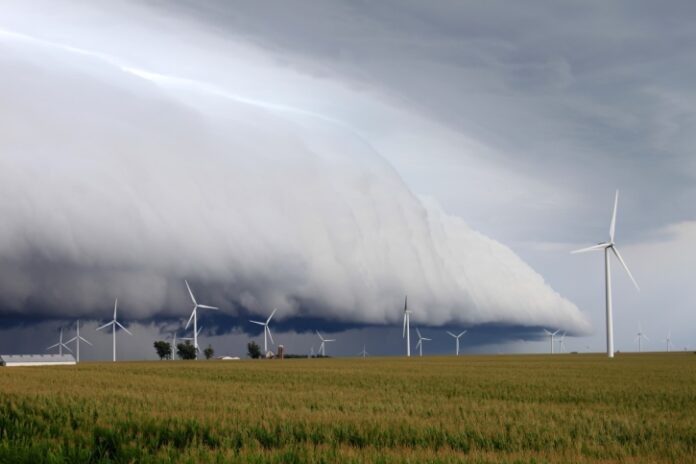A bill introduced by U.S. Rep. Tom Tiffany (R-WI) targets federal subsidies for renewable energy by banning taxpayer funding for the conversion of working farms to industrial-scale wind and solar power-generating facilities.
HR 6857, the Future Agriculture Retention and Management Act (FARM Act) would “amend the Internal Revenue Code of 1986 to provide that the energy credit shall not apply to certain types of energy production on agricultural land, and for other purposes.”
Tiffany’s bill would not bar developers from putting wind turbines and solar-panel arrays on the land of farmers willing to host the facilities, but would end taxpayer subsidies for farmland conversions.
Renewables Produce Little Power
Despite years of federal subsidies and state support for wind and solar power, Wisconsin still relies primarily on coal, nuclear, natural gas, and hydropower to satisfy its electric power demand, according to a study from the U.S. Energy Information Administration (EIA).
One reason is the intermittency of most renewables: solar panels in Wisconsin produced just 16 percent of their potential output in 2020, and wind turbines operated at just 27.5 percent of their capacity.
“One-tenth of Wisconsin’s in-state electricity net generation comes from hydropower, wind, biomass, and solar resources,” states the EIA. “Hydroelectric facilities are the largest contributors and accounted for almost half the state’s renewable electricity generation in 2020.”
In contrast, wind power accounted for about 30 percent of electricity generation from renewable sources and solar less than 4 percent.
‘Secure Our Food Sources’
Tiffany represents the predominantly rural 7th district, covering northwestern and central Wisconsin.
Agriculture is a major industry and employer in the district, where 60 percent of the farmland is used for crop production and thousands of additional acres serve as dairy farms.
Transforming productive farmland into vast industrial solar and wind facilities with taxpayer support is a bad bargain, putting American farmers and consumers at risk, Tiffany told Environment & Climate News.
“All across our nation, renewable energy carve-outs embedded in the federal tax code are forcing taxpayers to transform prime agricultural land into unreliable wind and solar farms,” said Tiffany. “This prompts me to ask: What happens when our farmland is covered with intermittent green energy? Where will our fiber, food, and clothes be sourced from? That is the question that must be posed, and that’s why I introduced the FARM Act to secure our food sources, protect our family farms, and eliminate the green energy boondoggles that help finance the siting of solar panels and wind arrays on our farmland.”
Locals Fight the Feds
Although Tiffany’s bill targets renewable wind and solar projects nationwide, there is widespread opposition to wind turbines in Wisconsin.
In Wisconsin’s Sheboygan County, a developer has proposed erecting 16, 673-foot-tall wind turbines on local farms. The proposal has stirred fierce local oppositions, with residents raising concerns about the turbines’ height, noise, shadow flicker, effect on neighboring property values, and threat to avian wildlife.
Despite local opposition, reports there is little locals can do to stop the project if it is approved by the Federal Aviation Administration and the state Public Service Commission, according to the Sheboygan Press.
At the federal level, Tiffany’s bill faces an uphill fight. Congress, through what are called “tax extenders,” has repeatedly voted to extend federal subsidies for wind and solar power, sometimes for a single year, sometimes for multiple years.
‘Losing Millions of Acres’
There is a price to be paid for states that become too reliant on intermittent wind and solar power, says Bill Balgord, Ph.D., president of Middleton, Wisconsin based Environmental Resource & Technology.
“Texas, in 2011 and again in 2021, suffered severe brownouts and blackouts caused in part by its growing dependence on wind power,” said Balgord. “Its isolated grid was no match for severe cold snaps that stilled its growing number of wind turbines precisely at a time when demand for electricity for households and businesses was greatest. States like Wisconsin should take heed to the problems attending overdependence on wind and solar power that don’t deliver in the crunch.”
Wind and solar take a lot of valuable farmland out of production for the relatively little amount of energy they produce per acre, says David Wojick, Ph.D., a Virginia-based energy analyst.
“It is a well-kept secret that wind and solar are so inefficient and land intensive that getting most of our juice from them would leave little land left for growing food,” said Wojick. “We are talking about losing millions of acres. This is why Rep. Tiffany’s bill makes so much sense nationally.
Bonner R. Cohen, Ph.D. (bcohen@nationalcenter.org) is a senior fellow at the National Center for Public Policy Research and a senior policy analyst with the Committee for a Constructive Tomorrow.



























[…] Stop Frying Our Farmland and Making It Blow Away! […]